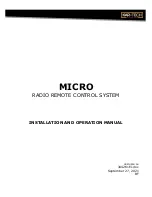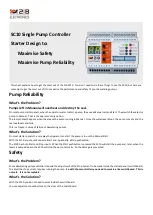
INSTALLATION, OPERATION & MAINTENANCE INSTRUCTIONS
3-Piece Threaded, Socket, Tube & Clamp End Ball Valves
DOC: IOM_FNW3PCBV_ ver_12-2007
Page 3 of 6
7.
Test the operation of the valve, checking for binding or misalignment. Always leak test the system before
using.
Clamp (Quick Disconnect) Ends
1.
Ensure that the correct style of clamp and gasket are used.
2.
It is not necessary to disassemble clamp end valves prior to installation.
3.
During installation, be sure the gasket is properly seated.
4.
Do not over tighten.
MANUAL OPERATION
1.
Ensure that the valve materials are compatible with the service and that the operating characteristics are
below the valves maximum.
2.
Open and close the valve by turning the handle one-quarter turn (90°). Valves may have a locking lever
device. If so equipped, slide the locking plate up the lever before operating.
3.
The valve is in the open position when the maximum handle length is parallel to the pipe.
4.
The valve is in the closed position when the maximum handle length is perpendicular to the pipe.
MAINTENANCE
WARNING
To avoid personal injury to your self, fellow workers, or damage to property from release of process fluids, before
performing any maintenance:
a.
Shut off all operating lines to the valve.
b.
Isolate the valve completely from the process.
c.
Release process pressure.
d.
Drain the process fluid from the valve.
1.
Ball valves, if properly used, do not require internal lubrication or maintenance. However, a visual inspection
should be part of a regular maintenance program. A higher frequency of inspection is recommended for
valves operating under extreme conditions. Also, for proper operation it is recommended that the valve be
opened and closed at least twice a year.
2.
Before any maintenance, open and close the valve at least once to release the pressure completely from the
valve body.
3.
For stem leaks, if the valve has adjustable packing, use a crescent wrench, or spanner wrench as needed, to
turn the packing nut/gland clockwise at quarter-turn intervals until the leak stops. If the packing nut/gland can
not be turned clockwise any further, or if the valve continues to leak, it will have to be replaced or repaired.
NEVER REPLACE VALVE PACKING WHILE THE VALVE IS IN SERVICE.
4.
Valves with body seals can be rebuilt by using a “Soft Goods” rebuild kit from FNW.
Assembly and Disassembly
For the following assembly and disassembly instructions, refer to Figure 1. Note: All 3-piece ball valves may not
have the same components listed below. Consult the drawing for the specific valve series for correct bill of
materials.
























